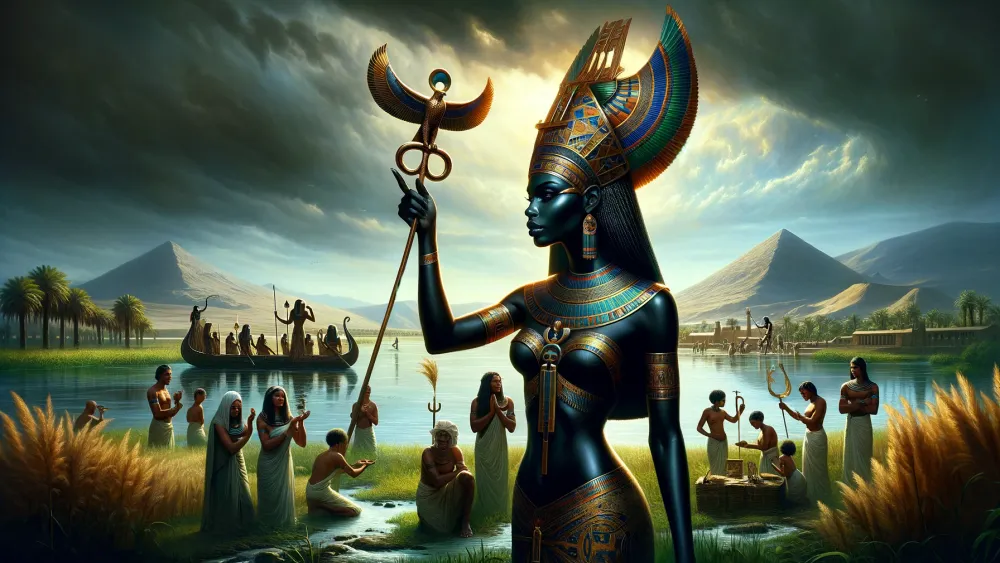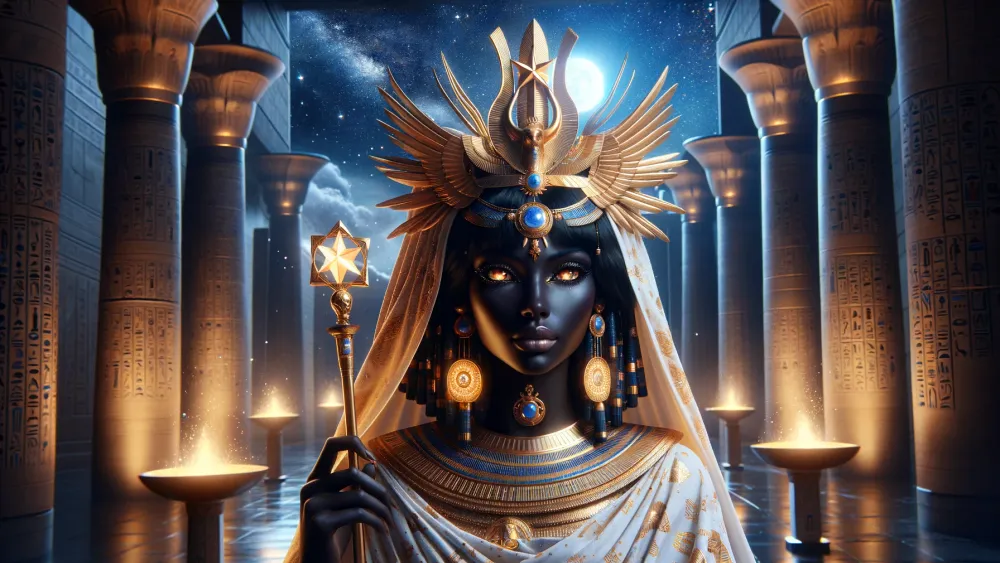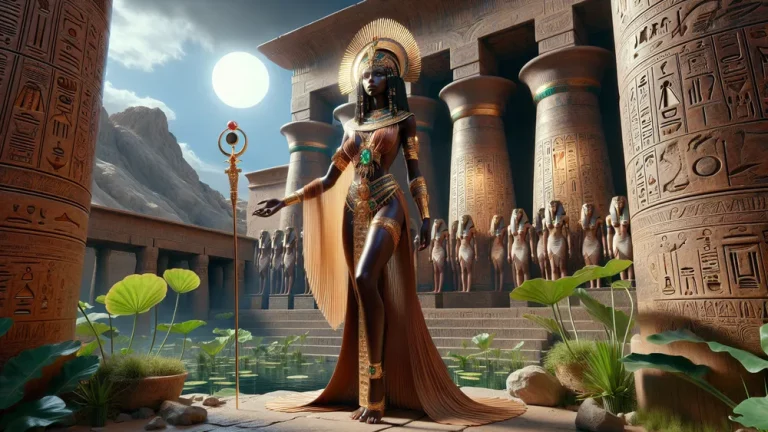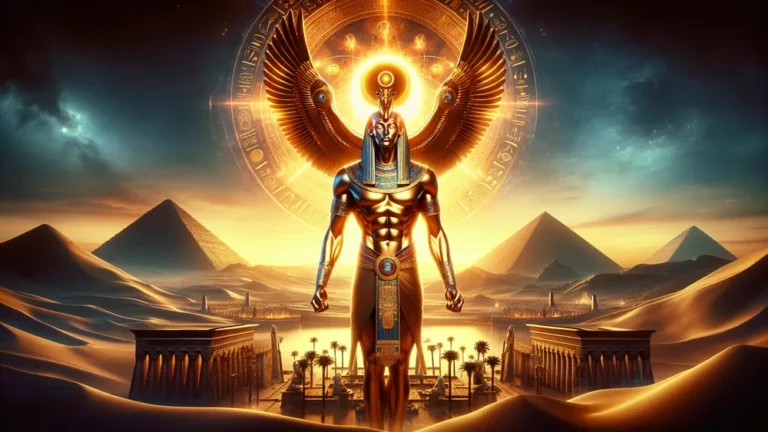Ancient Egyptian Goddess Sopdet: Star Of Sirius
The ancient Egyptian goddess Sopdet, who is linked to the star Sirius, was super important in the religious and farming life of ancient Egypt. People saw her as a goddess of fertility and the one who brought the yearly Nile flood. This flood was crucial for Egyptian civilization.
Key Points:
- Sopdet, an ancient Egyptian goddess, was linked to the star Sirius and was vital for fertility and the Nile flood.
- She marked the start of the Egyptian New Year with the rising of Sirius in the sky.
- Sopdet was worshipped from the Old Kingdom to the Ptolemaïc period.
- People offered food, drink, and symbolic items during the Nile’s flooding to honor Sopdet.
- Sopdet’s name means skilled and she was connected to symbols like stars and cows.
- The goddess had a close connection with Osiris and Isis in Egyptian mythology.
- Sopdet’s influence extended to Greek, Roman, and even medieval European cultures.
Her connection to the rising of Sirius in the sky marked the start of the Egyptian New Year and signaled the much-needed flooding of the Nile. This blog post will look into the beginnings, stories, worship, and lasting impact of Sopdet. It will show how this star goddess influenced both ancient times and later cultures.
Get ready to dive deep into the world of Sopdet!
Sopdet: Overview and Key Facts
| Thing | Details |
|---|---|
| Name | Sopdet (sometimes called Sothis in Greek) |
| Role | Goddess of fertility, the Nile’s flooding, and the star Sirius |
| Symbols | Star, cow, and she often has a headdress with a star |
| Connection to Sirius | Linked to the rising of Sirius, which marked the Egyptian New Year |
| Myth Ties | Connected to Osiris and Isis in different stories |
| Worship Time | Mostly during the Old Kingdom to the Ptolemaïc period |
| Main Temples | Temples in Sothis, Thebes, and other important places |
| Rituals and Offerings | People gave food, drink, and symbolic items during the Nile’s flooding |
| Cultural Impact | Affected later Greek and Roman myths and art |
| Archaeological Finds | Various things like statues, writings, and temple carvings |
This table gives a quick look at Sopdet’s importance and her many roles in ancient Egyptian life. It’s a lot to take in, but it’s all fascinating stuff!
The Origins of Sopdet
To really get why Sopdet mattered, we gotta go back to the start. Let’s jump into her early mentions and where her name comes from.
Historical Background
The first mentions of Sopdet show up in ancient Egyptian texts and artifacts, like the Pyramid Texts from the Old Kingdom, around 2400 BCE. Think of it like finding an old, dusty diary in your attic. These texts identified Sopdet as a goddess tied to the star Sirius, which was a big deal for marking the Egyptian New Year.
People worshipped her because they thought she brought the annual flooding of the Nile, which was like winning the lottery for their crops.

Key archaeological finds related to Sopdet include:
- Pyramid Texts: These old writings talk about Sopdet and her link to Sirius.
- Temple Inscriptions: Found in places like Thebes, these show how folks worshipped her.
- Statues and Amulets: Little artifacts that people kept at home or wore for good luck and blessings.
Sopdet, an ancient Egyptian goddess linked to the star Sirius, was highly esteemed for her association with the annual flooding of the Nile, crucial for the success of crops and marking the Egyptian New Year.
Etymology and Symbolism
The name “Sopdet” is a real gem when you dig into it. It comes from the ancient Egyptian word “spdt,” which means “sharp” or “skilled.” Think of calling someone “sharp” because they’re really good at something; that’s the vibe here. Sopdet was tied to the star Sirius, seen as a sharp, bright point in the sky.

This star was a big deal because its appearance meant the Nile’s flooding season was about to start, which was huge for ancient Egyptians.
Symbols linked to Sopdet include:
- Star: Representing Sirius, the brightest star in the night sky.
- Cow: Often connected to fertility and motherhood, which makes sense given her role in bringing the Nile’s life-giving floods.
- Headdress with a Star: A common depiction in art, showing her connection to Sirius.
Sopdet and the Star Sirius
Alright, so we’ve got the lowdown on Sopdet’s name and her symbols. But wait, there’s more! Let’s jump into her super cool connection with the star Sirius. This is where things get really wild.
Astronomical Importance
Sopdet and Sirius were like cosmic pals. The ancient Egyptians would eagerly wait for the heliacal rising of Sirius, which is when the star pops up in the dawn sky just before sunrise after being hidden by the sun for about 70 days. This was a big, big deal because it meant the Nile’s annual flooding was about to start, which was crucial for their farming.
Think of it like waiting for your favorite show to return after a long hiatus; that’s how they felt about seeing Sirius again. Sirius was a key player in the Egyptian calendar. They used a solar calendar, but they also depended on Sirius showing up to mark the start of their New Year, called Wepet Renpet.
This happened around mid-July in our calendar. The Nile’s flooding brought fresh, fertile soil to the farmlands, kind of like getting a fresh start every year. They even had a special festival to celebrate, sort of like how we go all out for New Year’s Eve with fireworks and parties.
Here’s a quick look at how Sirius fit into their calendar and farming cycles:
| Event | Time of Year (Modern Calendar) | Significance |
|---|---|---|
| Heliacal Rising of Sirius | Mid-July | Start of the Egyptian New Year |
| Nile Flooding Begins | Late July to Early August | Brings fertile soil for farming |
| Harvest Season | November to February | Time to gather crops |
The Inundation of the Nile
Sopdet was like the ancient Egyptians’ go-to weather guru. They thought she had a direct line to the annual flooding of the Nile, which was a massive, massive deal for their farming. The Nile’s flooding brought in nutrient-packed silt, making the soil super fertile and just right for growing crops.
Think of it like waiting for the rain to finally water your garden after a long dry spell; that’s how vital the Nile’s flooding was for them. Without it, their crops would fail, and food would be scarce.
The Egyptians had all sorts of rituals and celebrations to honor Sopdet and make sure the flooding happened as it should. They would pray, perform ceremonies, and even throw big festivals. Here are some of the things they did:

- Prayers and Offerings: People would pray to Sopdet and offer food, drink, and other gifts to make her happy.
- Ceremonial Processions: They would have processions with priests and priestesses carrying statues of Sopdet through the streets.
- Festivals: There were big festivals with music, dancing, and lots of food to celebrate the start of the flooding season.
Sopdet in Mythology
Alright, so we’ve looked at how Sopdet was tied to the natural world. Now, let’s jump into her role in ancient Egyptian myths and stories. Her connections with other gods and goddesses? Totally fascinating.
Sopdet and Osiris
Sopdet and Osiris had this really cool thing going on in Egyptian mythology. Sopdet was like Osiris’s cosmic GPS, guiding him in the afterlife. Osiris, who was the god of the afterlife and resurrection, needed all the help he could get to navigate the underworld. Sopdet, connected with the star Sirius, was thought to light his way.
Imagine trying to find your way in a pitch-dark forest; having a bright star to guide you would be a game-changer, right? One myth tells how Sopdet, shining brightly in the sky, helped Osiris find his way to the afterlife, ensuring he could fulfill his role as the ruler of the dead.
Sopdet, linked to the star Sirius, played a crucial role in guiding Osiris through the afterlife in Egyptian mythology.
Sopdet and Isis
Sopdet and Isis had this really intriguing link in Egyptian mythology. Sometimes, folks thought of Sopdet as just another side of Isis, like how you might see different sides of a friend depending on the situation. Isis, the goddess of magic and motherhood, shared a lot of symbols with Sopdet. For example, both were tied to stars and the sky.

Sopdet was linked to Sirius, the brightest star, while Isis often had a star above her head. It’s like having a favorite shirt that you wear for different occasions, but it still represents you.
They both had roles in guiding and protecting, whether it was Sopdet lighting the way with her star or Isis using her magic to help her followers. This overlap made them both super important in Egyptian beliefs. They even shared symbols like the cow, which represented fertility and nurturing. It’s amazing to think about how these connections made their mythology so rich and layered.
Sopdet and Isis were seen as interconnected in Egyptian mythology, like two sides of the same coin, each representing different aspects but sharing symbols and roles in guiding and protecting.
Worship and Temples
Alright, so we’ve talked about Sopdet’s ties with other gods. Now, let’s jump into how people worshipped her and the temples they built. This will give us a peek into the rituals and offerings made in her name.
Temples Dedicated to Sopdet
There were some pretty cool temples dedicated to Sopdet scattered across ancient Egypt. One of the most notable ones was in Sothis, a city named after the goddess herself. This temple was a big deal because it was a central place for worshipping Sopdet and celebrating the heliacal rising of Sirius. Imagine a place bustling with activity, where people gathered to honor the goddess.

Another important temple was located in Thebes, which was a major religious hub. This temple had some unique architectural features, like columns decorated with star motifs and walls covered in inscriptions praising Sopdet. It’s like walking into a room where every corner tells a story about the goddess.
People would come together, share stories, and participate in rituals. It’s fascinating to think about how these temples served as both spiritual and social hubs. Some temples even had special chambers dedicated to observing the stars, which makes sense given Sopdet’s connection to Sirius.
Rituals and Offerings
So, when folks wanted to honor Sopdet, they did some pretty cool stuff. They’d give her things like bread, beer, and flowers. These were everyday items, but they meant a lot when offered to the goddess. It’s kinda like bringing your favorite snack to a friend’s house; simple but meaningful. People also made little statues or amulets of Sopdet.
They thought these would bring them good luck and keep them safe. Imagine carrying a tiny lucky charm everywhere you go. These rituals were a big part of daily life. For instance, during the heliacal rising of Sirius, which kicked off the Nile’s flooding season, people would go all out with ceremonies to honor Sopdet. This was super important because the flooding brought fertile soil, which was a big deal for farming.
Think of it like waiting for the rain to water your garden, but on a massive scale.
Pantheon of Egyptian Mythology Gods
Ancient Egyptian mythology is jam-packed with a wild mix of gods and goddesses, each with their own quirky stories, symbols, and jobs. You’ve got Ra, the sun god, shining bright, and then there’s Anubis, the god of the afterlife, who’s all about the mysteries of death. These deities were super important in the everyday lives and spiritual beliefs of the ancient Egyptians.
If you’re itching to dive deeper into this crazy world of divine beings, check out this full list with all Egyptian gods. It’s a thorough guide that covers the big names and even some of the lesser-known figures, giving you a complete picture of the Egyptian pantheon.
FAQs
1. Who was Sopdet in ancient Egyptian mythology?
Sopdet in ancient Egyptian mythology was the goddess associated with the star Sirius and the annual flooding of the Nile.
2. How is Sopdet connected to the star Sirius?
Sopdet is connected to the star Sirius as she personifies the star, which heralded the annual flooding of the Nile.
3. What rituals were performed in honor of Sopdet?
Rituals performed in honor of Sopdet often included offerings of food, drink, and symbolic items to invoke her blessings.
4. How did Sopdet influence other cultures?
Sopdet influenced other cultures through her association with the star Sirius, which was adopted and adapted in Greek and Roman mythology.







